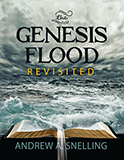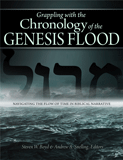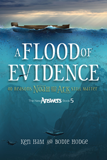
The Flood: From Creation to New Creation
Genesis highlights the global extent of the flood with language and themes that echo the Genesis 1 creation account.
One way to appreciate the extent of the flood in Genesis 6–9 is to see how the language and themes of new creation in Genesis 8 echo that of creation in Genesis 1. This is because the order and sequence of events in Genesis 8, though condensed, closely follow the pattern of creation in Genesis 1. By doing this, Moses shows the global extent of the flood. Before looking at Genesis 8, it is important to remember the context of the flood in Genesis 6.
Before the Flood
One way to appreciate the extent of the flood in Genesis 6–9 is to see how the language and themes of new creation in Genesis 8 echo that of creation in Genesis 1.
Genesis 6 begins by alluding to Genesis 1. In Genesis 6:5, “The Lord saw that the wickedness of man was great in the earth [ʾereṣ].” This alludes to Genesis 1:31, where “God saw everything that he had made, and behold, it was very good.” The “very good” earth (ʾereṣ) that God created, by Noah’s day, had become wicked, and this wickedness is all-inclusive (all people) except for Noah (Genesis 6:9). Genesis 6:11–13 then brings us into the context of the flood where God reveals to Noah his purposes for destroying the earth:
Now the earth was corrupt in God’s sight, and the earth was filled with violence. And God saw the earth, and behold, it was corrupt, for all flesh had corrupted their way on the earth. And God said to Noah, “I have determined to make an end of all flesh, for the earth is filled with violence through them. Behold, I will destroy them with the earth.”
These verses also help clarify the meaning of the word “earth” (ʾereṣ), as they refer to the earth God created in Genesis 1. Genesis 6:11 tells us that the “earth” (ʾereṣ) was corrupt in God’s sight and filled with violence. The earth that was “filled” (mālāʾ) with violence is the same earth that God commanded mankind (Adam and Eve) to “fill” up in Genesis 1:28: “Be fruitful and multiply and fill [mālāʾ] the earth.” This can only be a reference to the whole earth and not simply the region of Mesopotamia (i.e., a local flood). Genesis 6:11–13 sets up the context of the flood, which is in God’s sight (literally before God). The extent of the flood is not from Noah’s perspective but God’s, as it is he who sees that the whole earth is corrupt. This refutes the idea that the flood only appeared to cover the then-known land mass (the limited perspective of the biblical author). The waters of the flood brought the whole world back to being a water mass (Genesis 7:19–20) as it was on day two of creation (Genesis 1:6–8). In Genesis 1, God takes what is formless and void (uninhabitable) and makes it into a habitable earth. But in the flood, God destroys the earth, and it returns to being uninhabitable for mankind and animals.
After the Flood
The six days of creation in Genesis 1 generally correspond to the description of the new creation in Genesis 8 (see table below).1 Both chapters are set in a chronological framework. Genesis 1 has six chronological days of creation, and Genesis 8 marks strategic points of the retreating waters by dating the progression by “year,” “month,” and “day” until its completion (Genesis 8:13–14).2
By corresponding Genesis 8 with Genesis 1, Moses shows us the worldwide (not local) extent of the flood.
In Genesis 8, the words “God remembered Noah” (Genesis 8:1) explain the reason for the reversal of the floodwaters as it results in action. God makes a wind (rûaḥ), echoing the description of God’s Spirit hovering over the water (Genesis 1:2), to blow over the earth so that the waters could subside (Genesis 8:1b–2a). In Genesis 8:2, we see the reversal of Genesis 7:11–12 as the fountains of the deep (tǝhôm) (Genesis 1:2) and the windows of heaven (šāmayim) are closed (Genesis 1:6–8). The waters then recede from the earth, and eventually, the tops of the mountains appear (Genesis 8:3–5, 1:9). At the first appearance of earth, Noah sends out a raven (which flies back and forth) and then finally a dove to see if the waters had subsided from the face (ʿal-pǝnê) of the ground (Genesis 8:7–8, 1:20). The dove failed to find a resting place as the waters still covered the face of the whole earth (Genesis 8:9), but fourteen days later, Noah sent out the dove a third time and this time it did not return (Genesis 8:10–12). It took 221 days for the floodwaters to abate completely and for the ground’s surface to dry out adequately enough for Noah, his family, and the animals to leave the ark (Genesis 8:5–17). The animals that disembark the ark are exhorted to be “fruitful and multiply on the earth” (Genesis 8:17), which is similar to what God said on days five and six of creation (Genesis 1:20–22, 24–25, 28–30). The picture in Genesis 8 is that of a return to the work of creation “in the beginning,” though not perfect, as it was in Genesis 1.
When Noah comes out of the ark, God’s commitment to creation is seen again in that the same commandment he gave to Adam he now gives to Noah: “Be fruitful and multiply and fill the earth.” (Genesis 9:1, 1:28). Noah is seen as a new Adam who is to continue the original creation mandate—now carried out in a fallen world. Although the judgment of the flood changed the earth, it did not change mankind’s heart, which is still evil (Genesis 8:21). This is important, as part of the covenant is the provision of the protection of human life because it is made in the image of God (Genesis 9:6). Just as in Genesis 1, Moses’ interest is on mankind’s creation in God’s image.
| Genesis 1 | Genesis 8 | |
|---|---|---|
| First Day | earth, deep, Spirit [rûaḥ], waters (1:2). | wind [rûaḥ], earth, waters, deep. (1b–2a) |
| Second Day | waters, heaven (1:7–8). | heaven (8:2b). |
| Third Day | water, dry ground appears (1:9). | water, tops of mountains appear. (8:3–5). |
| Fourth Day | No need for the “re-creation” of the sun, moon, and stars. | |
| Fifth Day | birds, above the earth, across [ʿal-pǝnê] the expanse (1:20). | raven, from the earth, from the face [ʿal-pǝnê] of the ground (8:7–8). |
| Sixth Day |
creature, livestock, creatures that move along the ground, animals (1:24). man, image (1:26). Be fruitful and multiply and fill the earth (1:28). |
creature, birds, animals, creatures that move along the ground (8:17). image, man (9:6). Be fruitful and multiply and fill the earth. (9:1). |
At the flood, the whole world was completely undone and had to be started over again. In Genesis 8, we see the new creation of the world after the global flood. By corresponding Genesis 8 with Genesis 1, Moses shows us the worldwide (not local) extent of the flood.
Footnotes
- For the information in the chart, see Kenneth Mathews, Genesis 1–11:26: The New American Commentary Vol. 1A (Nashville Tennessee: B&H Publishing, 1996), 383.
- Kenneth Mathews, Genesis 1–11:26: The New American Commentary, 383.
Recommended Resources

Answers in Genesis is an apologetics ministry, dedicated to helping Christians defend their faith and proclaim the good news of Jesus Christ.
- Customer Service 800.778.3390
- Available Monday–Friday | 9 AM–5 PM ET
- © 2026 Answers in Genesis






